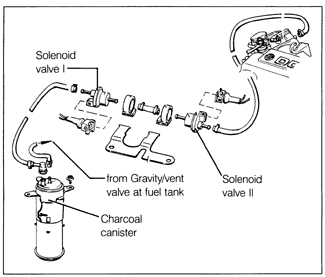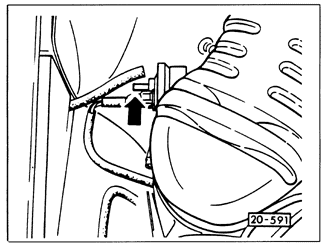Testing Charcoal Canister Solenoid Valves (CIS-E Motronic)The solenoid valves are on a bracket mounted on the air flow sensor housing. Fig. 4-24 is an exploded view of the charcoal canister, the solenoid valves, and hose routing. Solenoid valve I operates as a frequency valve, pulsing open and closed. The valve should hum or buzz as the Motronic control unit varies the valve's duty cycle-the ratio of open time to closed time. The ratio varies according to air flow sensor plate position and engine rpm. Solenoid valve II has an on/off function, opening when engine speed rises above 300 rpm, and closing to seal the system when the engine is not running. To check each solenoid valve mechanically, disconnect the harness connector and both hose connections, and blow into the valve. With the ignition off, valve I (gray) is normally open; air should pass through. Valve II (black) is normally closed; air should not pass through. If either valve does not perform as described, it is faulty and should be replaced.

For a functional test of the control system, start with the engine cold-coolant temperature below 140°F (60°C). Disconnect the hose from solenoid valve I, as shown in Fig. 4-25, and check for vacuum at the valve connection. With the engine running at idle the valve should not be cycling and there should be no vacuum. As the engine coolant temperature warms above 140°F (60°C) there should be strong vacuum at the valve connection for about 30 seconds, then solenoid valve I should begin cycling, reducing the apparent vacuum to little or none.

If in doubt about the function of this system, note that the Motronic control of solenoid valve I is one of the systems that can be checked by an authorized Volkswagen dealer's special diagnostic test equipment. See 3.4 CIS-E Motronic Fault Diagnosis. |